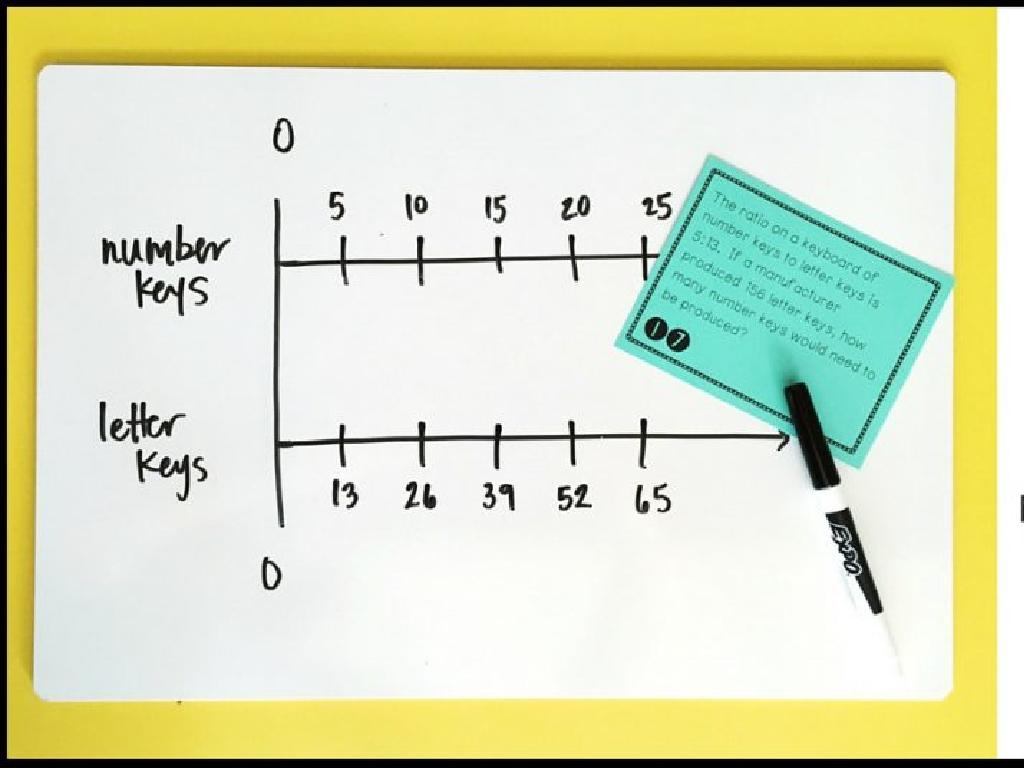Evaluate Numerical Expressions Involving Integers
Subject: Math
Grade: Eighth grade
Topic: Integers
Please LOG IN to download the presentation. Access is available to registered users only.
View More Content
Welcome to Integers!
– Introduction to integers
– Integers include whole numbers and their opposites, e.g., -3, 0, 4.
– Positive vs. negative numbers
– Positive numbers are above zero, negative numbers are below.
– Integers in daily life
– Temperatures, bank balances, and elevations use integers.
– Applying integers to real problems
– Solve problems like temperature changes and account balances.
|
This slide introduces the concept of integers, which are the set of whole numbers and their opposites, including zero. It’s crucial to help students understand the difference between positive and negative numbers, as this is a foundation for working with integers. Provide real-life examples where integers are used, such as in measuring temperatures (both above and below zero), keeping track of money (earnings and debts), or understanding above and below sea level elevations. Encourage students to think of integers in terms of everyday situations to make the concept more relatable. The goal is to prepare students to apply their understanding of integers to solve real-world problems involving numerical expressions.
Understanding Integers
– Define integers
– Integers include all whole numbers and their negatives
– Compare integers with other numbers
– Natural numbers start from 1, whole numbers include 0, integers include negative numbers
– Identify integers in contexts
– Temperatures below zero, bank debts, or elevations below sea level
– Practice with integer examples
|
Integers are the set of whole numbers that include all the positive whole numbers, zero, and their negative counterparts. Unlike natural numbers which begin from 1 and whole numbers which include 0, integers extend to include negative numbers as well. This concept is fundamental in understanding number lines and algebra. Provide examples of integers from real-life contexts such as temperatures, especially those below zero, to illustrate negative integers, or discuss financial contexts like debts to explain negative values. Encourage students to identify integers in various scenarios and practice with examples to solidify their understanding. This slide will set the foundation for evaluating numerical expressions involving integers.
Understanding Numerical Expressions
– Define Numerical Expression
– A mathematical phrase combining numbers and operators
– Identify Terms, Coefficients, Constants
– Terms are parts separated by + or -, coefficients multiply variables, constants are fixed numbers
– Explore simple expression examples
– For instance, 3x + 4 and 7 – 2y are simple expressions
– Practice with class examples
– We’ll solve expressions like 5 + (-3) and 4(2) – 3
|
This slide introduces the concept of numerical expressions to eighth-grade students. Begin by defining a numerical expression as a combination of numbers and mathematical operators without an equality sign. Explain the components: terms are individual parts of the expression, coefficients are numbers that multiply variables, and constants are fixed numbers. Provide simple examples like 3x + 4, where 3 is the coefficient, x is the variable, and 4 is the constant. Engage the class with straightforward examples to evaluate, such as adding and subtracting integers, and multiplying them by constants. Encourage students to identify terms, coefficients, and constants in each example. This foundational knowledge will be crucial for their success in algebra.
Mastering Order of Operations: PEMDAS/BODMAS
– Understanding PEMDAS/BODMAS
– Parentheses/Brackets, Exponents/Orders, Multiplication/Division, Addition/Subtraction
– Why order matters
– Correct order ensures accurate results
– Practice with examples
– Solve 3*(2^2) – (4+5) and 7 + 2 * (3^2 – 1)
– Apply rules to solve expressions
|
This slide introduces the concept of Order of Operations, a fundamental principle in evaluating numerical expressions involving integers. PEMDAS/BODMAS is an acronym that helps students remember the correct sequence: Parentheses/Brackets, Exponents/Orders, Multiplication/Division (from left to right), and Addition/Subtraction (from left to right). Emphasize the importance of following this order to obtain accurate results. Provide practice problems that illustrate common scenarios where students must apply these rules. Encourage students to work through the problems step-by-step and discuss their solutions. This will help solidify their understanding and prepare them for more complex mathematical expressions.
Evaluating Expressions with Integers
– Rules for integer operations
– Add and subtract: same signs add, different signs subtract. Multiply and divide: same signs positive, different signs negative.
– Apply order of operations
– Remember PEMDAS: Parentheses, Exponents, Multiplication and Division (from left to right), Addition and Subtraction (from left to right).
– Walkthrough: evaluating expressions
– Let’s solve: (-3) + 4 × (2 – 6) ÷ (-2).
– Practice with class examples
– We’ll work through examples together to reinforce the concepts.
|
This slide introduces the fundamental rules for working with integers in mathematical expressions. Emphasize the importance of understanding the rules for adding, subtracting, multiplying, and dividing integers, as these are the building blocks for evaluating more complex expressions. The order of operations, or PEMDAS, is crucial for correctly interpreting and solving expressions. Provide a step-by-step walkthrough of an example expression, highlighting each step of the order of operations. Conclude with interactive practice, allowing students to apply these rules with guidance. This will help solidify their understanding and prepare them for more advanced math topics.
Let’s Practice Together: Evaluating Expressions
– Example 1: Evaluate -3 + 7 – (-2)
– Start with -3, add 7, then add 2 because subtracting a negative is like adding.
– Example 2: Evaluate 4 * (-5) / 2
– Multiply 4 by -5 to get -20, then divide by 2 to get -10.
– Guided practice with feedback
– Work through problems as a class, get help as needed.
– Understand integer operations
|
This slide is designed for an interactive class activity where students will practice evaluating numerical expressions with integers. Begin by solving the first example as a class, illustrating how to handle subtraction of a negative number. For the second example, demonstrate the rules for multiplication and division with negative numbers. Provide immediate feedback as students work through these problems, either individually or in small groups, to reinforce their understanding. Emphasize the importance of following the correct order of operations and recognizing how the operations change the sign of the result. Encourage students to ask questions and discuss their thought process to ensure a solid grasp of evaluating expressions with integers.
Avoiding Common Mistakes with Integers
– Remember the Order of Operations
– Follow PEMDAS: Parentheses, Exponents, Multiplication/Division, Addition/Subtraction
– Keep rules for negatives straight
– When multiplying/dividing: like signs = positive, unlike signs = negative
– Use tips to prevent errors
– Double-check work, use number lines, and pair up negatives
– Practice with examples
– Solve sample problems to reinforce concepts
|
This slide aims to help students recognize and avoid common mistakes when evaluating numerical expressions with integers. Emphasize the importance of the Order of Operations (PEMDAS) to solve expressions correctly. Clarify the rules for adding, subtracting, multiplying, and dividing negative numbers, as mixing these up can lead to errors. Provide tips such as double-checking work, visualizing with number lines, and grouping negative signs together. Encourage students to practice with examples and to learn from any mistakes they make. This will not only improve their skills but also build their confidence in handling integers.
Class Activity: Integer Expression Challenge
– Split into groups for expression challenge
– Solve and present complex integer expressions
– Explain your group’s problem-solving process
– Detail each step taken to reach the solution
– Engage in class discussion on various methods
– Compare different problem-solving strategies used
|
This activity is designed to promote collaborative learning and critical thinking as students work in small groups to tackle complex integer expressions. Each group will solve a given expression and then present their solution to the class, explaining the steps and reasoning behind their process. After presentations, lead a class discussion to explore the different approaches taken by groups, highlighting the benefits of diverse problem-solving strategies. Encourage students to ask questions and provide constructive feedback to their peers. As a teacher, facilitate the discussion and ensure that each group understands the correct methods for evaluating expressions with integers. Prepare 4-5 different expressions of varying difficulty for the groups to ensure that all students are challenged appropriately.
Homework and Further Practice: Integers
– Complete assigned practice problems
– Solve problems involving integer operations
– Explore online resources for extra practice
– Websites offer interactive integer exercises
– Review today’s lesson for mastery
– Revisit evaluating expressions with integers
– Preview next class’s topic
|
This slide is aimed at reinforcing the students’ understanding of evaluating numerical expressions with integers. Assign a set of practice problems that cover the range of concepts discussed in today’s lesson. Encourage students to use online resources such as educational websites and games that provide additional practice with immediate feedback. Remind students to review their notes and today’s work to ensure they have a solid grasp of the material. Also, give them a heads-up on the next topic so they can come to class prepared, possibly suggesting they look up introductory information to get a head start.






